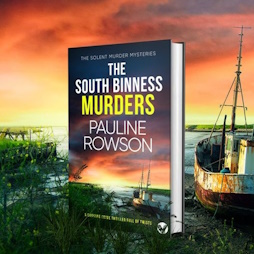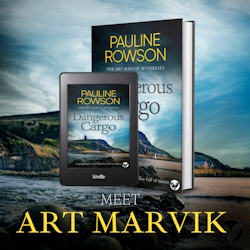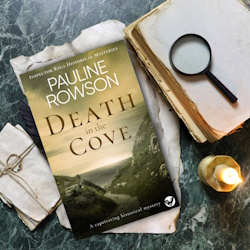
The prescribed wisdom states that novels are either plot driven or character driven. What, you may ask is the difference? And it's a very good question.
Essentially character driven novels centre around the protagonist's journey, his or her internal thoughts, the experiences he/she undergoes, the choices he/she makes which ultimately drive and affect the plot. Whereas plot driven novels focus on yes, you've guessed it, the plot. Here the protagonist takes a particular action which drives the plot and there are plot twists and turns as a result, action and conflicts which in turn drive the plot to its outcome. If that sounds rather confusing then don't worry, you are not alone. For me the distinction between the two is rather blurred although essentially critics and reviewers will say that my novels are plot driven and I agree to an extent. But the two aspects - character and plot - are invariably interlinked.
The characters drive the plot. Characters must be real in the sense of their motivations, behaviour and personalities, which along with their experiences, background and education drive their actions, which in turn affects the plot.
In the case of my rugged and flawed detective, Inspector Andy Horton, he is a man driven by a desperate need to belong and a strong sense of justice to see that those who exploit others, particularly the weak and vulnerable, are caught and banged up. He's greatly influenced by a childhood spent in children's homes and foster homes after his mother disappeared when he was ten, and his subsequent need to discover what happened to her. His actions, not always approved of by his nit-picking boss, the by-the-book-copper DCI Lorraine Bliss, affect the investigations and therefore to some extent the outcome of the plot.
 But the DI Andy Horton crime novels are also plot driven in that I start with a body in a certain location on Andy Horton's patch (Portsmouth and the Isle of Wight), or parts of a body (THE THORNEY ISLAND MURDERS), or a situation such as a missing person (THE COWES WEEK MURDERS and THE SOUTH BINNESS MURDERS) or even a mysterious phone call by a woman asking Horton to meet her on a ferry (THE RAT ISLAND MURDERS). So there is an investigation to undertake which gives the novel a certain structure and hence drives the plot.
But the DI Andy Horton crime novels are also plot driven in that I start with a body in a certain location on Andy Horton's patch (Portsmouth and the Isle of Wight), or parts of a body (THE THORNEY ISLAND MURDERS), or a situation such as a missing person (THE COWES WEEK MURDERS and THE SOUTH BINNESS MURDERS) or even a mysterious phone call by a woman asking Horton to meet her on a ferry (THE RAT ISLAND MURDERS). So there is an investigation to undertake which gives the novel a certain structure and hence drives the plot.
 In the Art Marvik mystery thrillers, Marvik is struggling to adjust to life out of the Royal Marines following injuries sustained in combat. He thought he’d be able to carve out a new career for himself on the sea, but his first job as a private maritime security operative goes very wrong when the luxury motor cruiser he was travelling on and had been detailed to guard, gets attacked by pirates in the Indian Ocean, and Marvik finds himself with a bullet in his shoulder and the boat’s owner dead. He failed on his first mission in civilian life, and DEADLY WAVES opens with him reeling from it. This all occurs before the first Art Marvik mystery thriller (DEADLY WAVES) opens. It is part of Marvik's back story as is the death of his parents in an underwater explosion off the Straits of Mallacca when he was seventeen.
In the Art Marvik mystery thrillers, Marvik is struggling to adjust to life out of the Royal Marines following injuries sustained in combat. He thought he’d be able to carve out a new career for himself on the sea, but his first job as a private maritime security operative goes very wrong when the luxury motor cruiser he was travelling on and had been detailed to guard, gets attacked by pirates in the Indian Ocean, and Marvik finds himself with a bullet in his shoulder and the boat’s owner dead. He failed on his first mission in civilian life, and DEADLY WAVES opens with him reeling from it. This all occurs before the first Art Marvik mystery thriller (DEADLY WAVES) opens. It is part of Marvik's back story as is the death of his parents in an underwater explosion off the Straits of Mallacca when he was seventeen.
Marvik’s not sure what lies ahead for him until a former Royal Marine comrade, amputee and intelligence expert, Shaun Strathen, enlists his help to find a missing computer scientist. Along with that a former girlfriend of Marvik’s goes missing after visiting him in his remote Isle of Wight cottage. Marvik finds himself attached to the UK's newly formed and covert National Intelligence Marine Squad (NIMS) led by Detective Chief Superintendent Crowder. Marvik's skills, background, experiences all dictate his actions but essentially, like DI Andy Horton, he is engaged on investigations. In Marvik's case though covert ones, and as he is not a police officer he can act outside the law.
Then there is my 1950s set detective series with Inspector Ryga. Again, I needed to understand what makes Ryga tick before I launched him on an investigation. His character needed to be formed and understood. I didn't want a hero in the traditional sense, and I also needed to bring in my trademark, or brand- the sea. I therefore chose to make Ryga an ex-merchant seaman whose ship was raided by the Germans resulting in him spending four years in a German prisoner-of-war camp.  His experience at sea, and as a prisoner-of-war, has made him unique in his approach to solving coastal based crimes. He's observant, analytical and reflective. He's witnessed compassion, cruelty, cowardice and heroism, mental breakdown and despair. He’s made a promise to himself that whatever happens after the war he’ll keep an open mind and never judge.
His experience at sea, and as a prisoner-of-war, has made him unique in his approach to solving coastal based crimes. He's observant, analytical and reflective. He's witnessed compassion, cruelty, cowardice and heroism, mental breakdown and despair. He’s made a promise to himself that whatever happens after the war he’ll keep an open mind and never judge.
With the Ryga novels also comes the challenge and enjoyment of reseaching the 1950s and for this I delve deep into railway timetables, ordnance survey maps of the period and police procedure and techniques of the time. In the latter I am assisted by former serving officers and the Police History Society. It is fascinating and enjoyable to write.
So have I answered the question what comes first plot or character? Probably not but whichever it is I hope it results in producing an intriguing and stimulating read.
Pauline Rowson lives on the South Coast of England and is the best selling author of many crime novels, published by Joffe Books. Her popular crime novels include the DI Andy Horton Solent Murder Mystery series, the Art Marvik mystery thrillers and the 1950s set Inspector Ryga mysteries. Subscribe to her newsletter for all the latest books news.